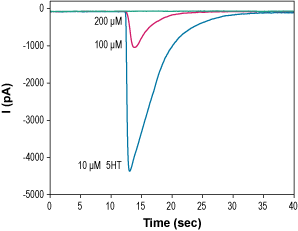Overview
- Tompson, A.J. et al. (2011) Neuropharmacology 60, 488.
- Huang, S.H. et al. (2003) Eur. J. Pharmacol. 464, 1.
 Alomone Labs Bilobalide blocks 5-HT3A receptors expressed in HEK 293T cells.5-HT3A receptor currents were elicited with 10 µM 5-HT, delivered every 3 minutes. Bilobalide (#B-145) was applied 30 seconds before stimulation at 100 and 200 µM as indicated, and inhibited the 5-HT induced current in a dose-dependent and reversible manner.
Alomone Labs Bilobalide blocks 5-HT3A receptors expressed in HEK 293T cells.5-HT3A receptor currents were elicited with 10 µM 5-HT, delivered every 3 minutes. Bilobalide (#B-145) was applied 30 seconds before stimulation at 100 and 200 µM as indicated, and inhibited the 5-HT induced current in a dose-dependent and reversible manner.
- Hannon, J. et al. (2008) Behav. Brain Res. 195, 198.
- Olsen, R.W. et al. (1990) FASEB J. 4, 1469.
- Tompson, A.J. et al. (2011) Neuropharmacology 60, 488.
- Huang, S.H. et al. (2003) Eur. J. Pharmacol. 464, 1.
Serotonin (5-hydroxytryptamine, 5-HT) is a monoamine neurotransmitter synthesized from the amino acid tryptophan by the enzyme tryptophan-decarboxylase. The 5-HT3 channel is a ligand-gated ion channel receptor of the Cys-loop channel family1.
The GABA(A) receptor is also a ligand-gated ion channel. It is the major receptor type for the GABA inhibitory neurotransmitter in the central nervous system2.
Bilobalide is a natural non-selective blocker of the 5-HT3A and GABA(A) channels. Bilobalide is a sesquiterpene trilactone extracted from the leaves of the tree Ginkgo biloba. Bilobalide has an effective concentration of 1-100 μM and an IC50 of 470 μM for the 5-HT3A receptor3 and an IC50 of 4.6±0.5 μM for the GABA(A) receptor. Bilobalide also binds to other anion Cys-loop receptors such as glycine receptors with a much higher affinity than to the 5-HT3A receptor.
Bilobalide inhibits direct GABA mediated currents from recombinant human GABA(A) receptors thus suggesting it enhances neuronal excitability. Bilobalide is used in traditional Japanese medicine as a memory enhancer, treating symptoms associated with mild-moderate dementia and improving cognitive functions related to old age and senility3.
Bilobalide (#B-145) is a highly pure, natural, and biologically active compound.

